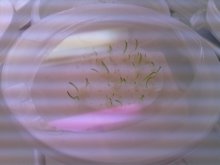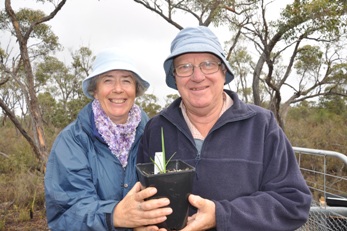Go to:
From 2015 to 2018, the ANPC partnered with the Royal Botanic Gardens Victoria to deliver the Orchid Conservation Program, now based at the gardens, which aims to save South East Australia’s unique and threatened orchids. This program is currently the only means by which these orchid species can be propagated in sufficient numbers to significantly reduce the threat of them becoming extinct in the wild. The program focuses on the management, ex-situ propagation and reintroduction of threatened orchids. Without a successful translocation program program, many of the threatened orchid species we are working on are likely to become extinct.
Other project partners were: the Wimmera Catchment Management Authority (CMA); Mallee CMA; the Port Phillip, Loddon Mallee and East Gippsland regions of the Department of Environment, Land, Water and Planning (DELWP); South Australian Government; South West Region of the NSW Office of Environment and Heritage; Australian National Botanic Gardens; Alcoa/Portland Aluminium; Hindmarsh Landcare Network; Australian Orchid Foundation; IUCN orchid specialist group, Trust for Nature; Parks Victoria; and private landholders.
Volunteers Josie Carrigan and Richard Thomson from the Australasian Native Orchid Society planting Metallic Sun orchids (Thelymitra mackibbinii) in Little Desert National Park. (Noushka Reiter) |  Supplementation of Desert Greenhood (Pterostylis xerophila) with Peter Kiernan from the Australasian Native Orchid Society. (Noushka Reiter) |
|---|
Numerous community groups also contributed to the success of the program including: Field Naturalists, Victorian Group of the Australasian Native Orchid Society, Friends of the Grampians, Friends of the Little Desert as well as many other individuals and community groups.
A big thank you to everyone who donated to our crowdfunding campaign. We raised an amazing $41,387! These funds helped to pay for the ‘fit out’ of the orchid conservation laboratory at the Gardens to propagate and grow the threatened orchids for reintroduction projects.
All Australian terrestrial orchids rely on a specific type of mycorrhizal fungi to germinate and sustain their growth throughout their lifecycle and many are pollinated by their own unique species of pollinator. Research over the last 15 years has improved orchid propagation and translocation techniques, enabling us to identify where the necessary pollinators live and also capture and grow the required mycorrhizal fungi.
All Australian terrestrial orchids rely on a specific type’ of mycorrhizal fungi to germinate and sustain their growth throughout their lifecycle and many are pollinated by their own unique species of pollinator. Research over the last 15 years has improved orchid propagation and translocation techniques, enabling us to identify where the necessary pollinators live and also capture and grow the required mycorrhizal fungi.
Saving the federally listed Metallic Sun-orchid and Wimmera Spider-orchid from weed invasion
The ANPC has partnered with Parks Victoria in a DEPI Communities for Nature grant to save the endangered Metallic Sun-orchid (Thelymitra epipactoides) and Wimmera Spider-orchid (Caladenia lowanensis). A significant population of both species exists within the Kiata Flora and Fauna Reserve (FFR) near Nhill in western Victoria, however they are under threat from invasion of Perennial Veldt Grass (Ehrharta calycina). This project aims to protect the plants within the reserve from becoming extinct through weed control. This work will also benefit the federally Endangered but less rare Greencomb Spider-orchid (Caladenia tensa) located within the Kiata FFR. The effect of the weed control on the vegetation and the orchid colonites within the reserve will also be monitored for its effectiveness.
News Archives
 Caladenia audasii (McIvor Spider-orchid). (Julie Whitfield) |  Caladenia audasii germinations. (Noushka Reiter) |
|---|
Two threatened NSW native orchids have recently been germinated symbiotically for the very first time. They are the Crimson Spider-orchid (Caladenia concolor) and the Sand-hill Spider-orchid (Caladenia arenaria). The ANPC is germinating the orchids for reintroduction trials to be undertaken next year in the state’s south west by the NSW Office of Environment and Heritage (OEH), funded through the NSW Government’s new Saving Our Species (SOS) program.
ABC Radio Goulburn Murray 4/4/14
Town and Country Magazine 7/4/14
Three Victorian threatened native orchids – the McIvor Spider-orchid (Caladenia audasii), the Bendigo Spider-orchid (Caladenia sp. aff. fragranitissima) and the Stuart Mill Spider-orchid (Caladenia cretaceae) have also recently been successfully germinated. These seedlings will eventually be reintroduced back into the wild as part of a translocation project being implemented by the Loddon Mallee Region of the Department of Environment and Primary Industries (DEPI) and Amaryllis Environmental.
ABC Rural 11/4/14 (includes audio)
Native Orchids in Australia
Australia has a higher proportion of orchids than any other temperate region of the world, with over 1700 species recorded. The majority of these are terrestrial (ground dwelling). Yet regrettably, 25% of global orchid extinctions have occurred on our continent.
Principally these extinctions are due to large scale changes in our environment over the past 200 years as a result of land clearing, land degradation and the introduction of weeds and rabbits to our continent. Many populations exist in uncertain environments, such as on private land, in roadside / rail reserves or on public land subjected to fuel reduction burning regimes. Of the 400 orchid species in Victoria, half are threatened with extinction, with 43 species listed on the federal Environment Protection and Biodiversity Conservation Act (1999). Orchids also represent a significant proportion of all threatened flora in Australia.

